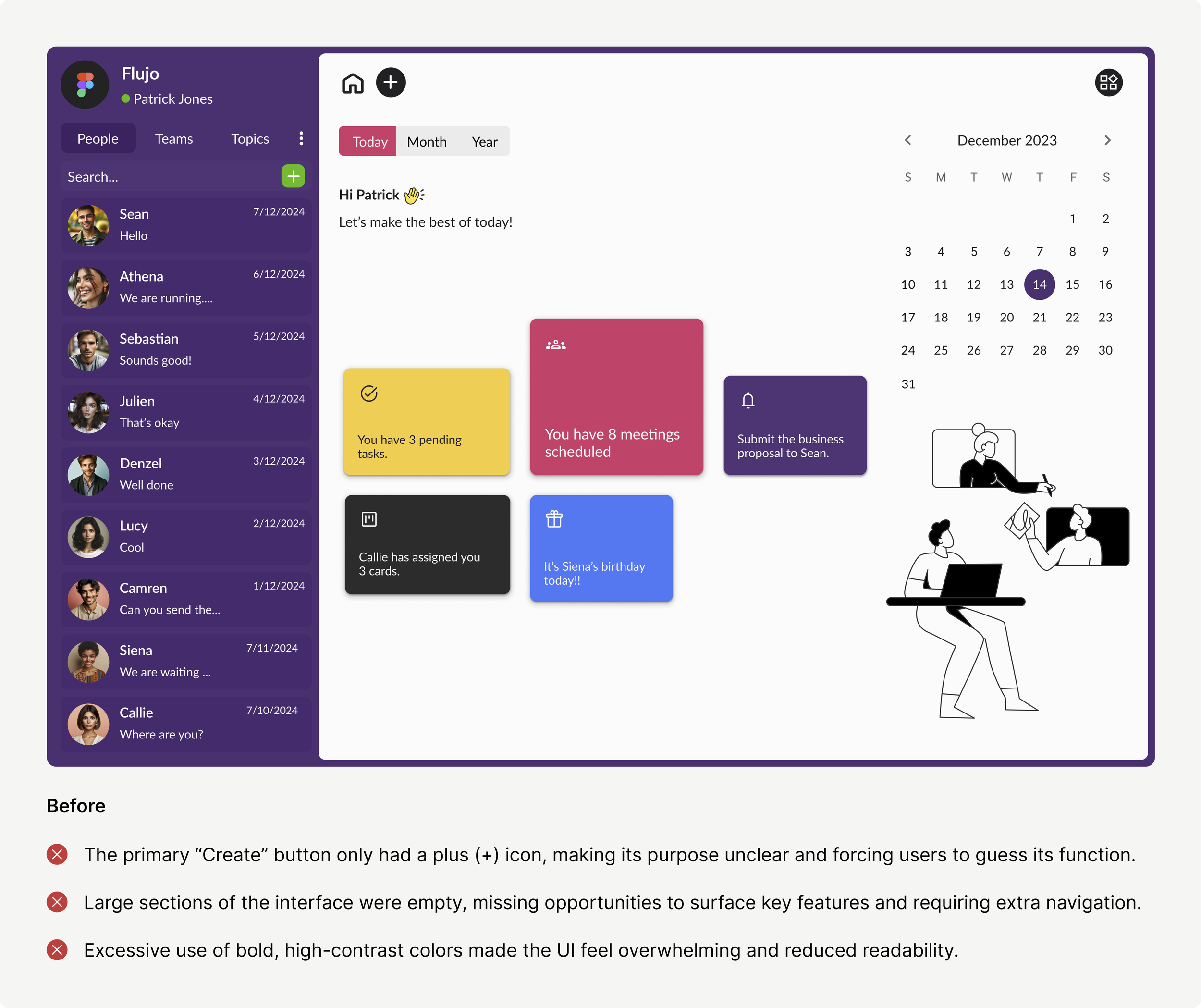How I redesigned Flujo’s AI-Powered productivity suite which boosted team efficiency by 1.4x & cut costs by 28%
Flujo is an AI-powered productivity suite that integrates essential workplace tools such as Calendar, Shared Drive, Messenger and many more to streamline workflows. Using NLP and machine learning, it predicts behavior, personalizes interactions, and reduces multitasking.
I joined as the second design hire right after its MVP launch in September 2019 to enhance the user experience and build AI-driven features—boosting team efficiency by 1.4x and help achieve product-market fit.
Context
My Contribution
End to End UX Research + Product Design
Team
Chief Product Officer, Lead UX Designer(myself), 25+ Engineers
Modalities
Web and Mobile
Vertical
AI-Powered Collaboration & Productivity Software.
Duration
Sept 2019 - Jan 2021
Launch
Results
Everyday, teams waste time juggling multiple workplace tools, leading to inefficiencies, miscommunication, and higher costs. Fragmented workflows slow productivity, scattered data delays decisions, and businesses struggle with rising expenses and poor collaboration.
Problem Space
Flujo is an AI-powered productivity suite that simplifies workflows by integrating essential tools into a single, intuitive platform. By automating repetitive tasks, AI reduces cognitive load, allowing users to focus on meaningful work. Machine learning personalizes workflows, adapting to individual habits for a seamless experience. This not only boosts productivity but also cuts operational costs by minimizing manual efforts and eliminating inefficiencies—helping teams work smarter, faster, and more efficiently.
Solution Highlights
I conducted different methods of research to understand the targeted user group, identify barriers, and define the design direction and feature prioritization.
User Research Process and Plan
01
18 User Interviews
Talked to 18 professionals to see which workplace tools they rely on, how much time they spend on them, and what frustrates them the most.
02
Literature Review
Dug into articles and research to uncover common productivity blockers in modern workplaces.
03
Affinity Mapping
Mapped out key themes from interviews and research using Affinity Mapping, making it clear which issues needed solving.
04
User Persona
Built user personas to help designers, developers, and marketers stay aligned on real user needs.
06
Disjointed Efforts
Competitor Analysis
05
Analyzed Notion, Slack, and Microsoft Teams to see how they tackled similar challenges and what could be done better.
01
Cognitive Overload
User Research Results and insights
The research revealed that traditional workplace tools operate in silos, leading to fragmented workflows, distractions, and inefficient collaboration. Employees waste valuable time switching between multiple platforms, struggling to stay organized and focused.
Constant multitasking makes work less efficient and mentally exhausting.
Frequent interruptions reduce employee performance and focus
03
Scattered Workflows
Essential tasks like messaging, file sharing, and meetings are spread across different platforms, creating friction.
04
Communication Gaps
Workplace Distractions
02
Poor communication leads to misunderstandings and trust issues within teams.
Outdated Communication Methods
05
Many employees still rely heavily on email, slowing down real-time collaboration.
Lack of integration between tools results in incomplete tasks and misalignment among team members.
After immersing myself in user research, I mapped out the Information Architecture to outline the product suite’s structure. This helped define key features, show how different pages connect, and ensure a seamless user experience. It also shaped the product’s taxonomy by grouping related content intuitively.
Mapping the Experience
I mapped goals to measurable signals of success, aligning them with metrics to track progress:
Set goals & vision
Design & Iterations
First Iteration
In ensuring a solution that caters to the target users' unique challenges, I iterated on different approaches to the user flow. These approaches were put through rigorous testing to gain perspective on usability. Here are two such notable iterations.The initial iteration did not have AI-Powered assistant. The home page was created to show updates regarding each feature. However, there was room for lot of improvement in terms of UX.
Second Iteration
The first iteration included a productivity tips container due to time and resource constraints. While this was a step in the right direction, it didn’t fully address users’ needs for a smarter, more automated workflow.
Third Iteration
This iteration focused on enhancing the visual hierarchy and modernizing the UI for a more polished, intuitive experience.
Mobile Application
In moments when work can’t wait until they reach the desk. Thankfully, we have built an mobile application to connect with their team, review messages and move work forward using Flujo’s Mobile apps.
What I Learned
🔭 Big-Picture Thinking Drives Impact A holistic approach made me more adaptable, helping me identify broader opportunities rather than isolated UX fixes. This led to higher engagement and a seamless user experience.
📝 Clear Communication is Key Great UX isn’t just about visuals—intuitive language and accessibility are just as crucial for a smooth experience.
🤝 Embedded Design Enhances Collaboration Working closely with developers in an agile setup ensured faster iterations, stronger teamwork, and better outcomes.
Areas of Improvement
📈 Scalability from the Start
Designing flexible UI patterns and scalable systems would have helped Flujo evolve more smoothly.
🤖 Making AI More Human
Enhancing context-aware suggestions and natural interactions would improve engagement and user trust.
Future Directions
🔗 Deeper Third-Party Integrations Seamless syncing with Slack, Google Drive, and Notion to make Flujo the ultimate workspace hub.
📱 Expanding Multi-Device Access Introducing voice commands and wearable support for effortless workflow management anywhere.

















